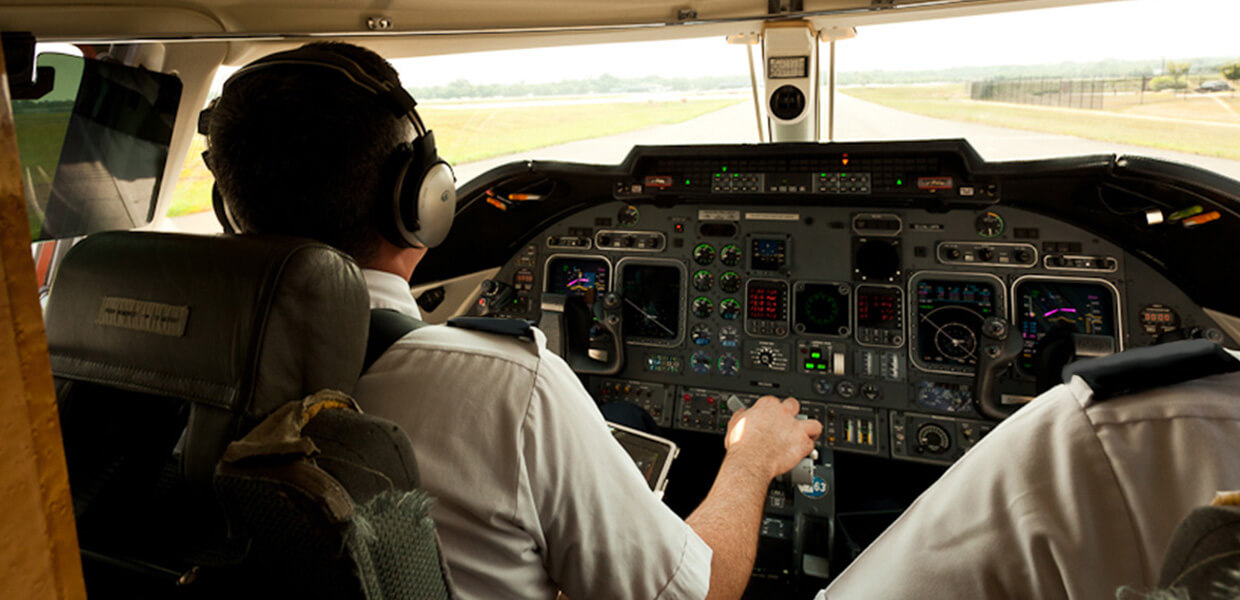
A new NBAA workforce study yielded some interesting results.

Business aircraft operators continue to work hard to attract and retain qualified personnel in a challenging employment environment. In 2017, as part of its support of those efforts, NBAA’s Business Aviation Management Committee (BAMC) conducted a study to determine why pilots leave business aviation. In 2018, BAMC conducted a new study to explore the issue further in an effort to determine the extent of pilot and maintenance technician turnover. The results of the study were released at NBAA’s 2018 Business Aviation Convention & Exhibition.
“Last year [2017], we looked at the issue from a qualitative standpoint – why are pilots leaving business aviation?” said Chris Broyhill, Ph.D, CAM and BAMC member. “This year, we wanted to determine how significant the problem actually is, as well as what is necessary to retain qualified professionals.”
An 18-question survey was sent to 3,450 aviation managers. A total of 510 responses were received, with 405 being deemed usable, complete surveys from operators that collectively fly 1,781 aircraft. The majority of respondents (337) were Part 91 operators. Twenty-two management companies also responded, as did 28 charter operators.
The survey asked how many pilots have left each respondent’s organization since January 2015, where they went, and the reasons those pilots gave for leaving. The survey asked maintenance technicians similar questions.
The survey also asked aviation managers how difficult it has been to retain pilots since the beginning of 2015, compared to before 2015; whether there have been a smaller number of qualified candidates for open pilot positions; and to expand on or clarify the answers provided.
The study confirmed some of the industry’s existing beliefs about pilot and technician turn-over, but debunked others.
TURNOVER IS SUBSTANTIAL
Some 63 percent of responding operators experienced pilot turnover since 2015, with at least 13 percent of the pilot force of respondents leaving business aviation.
Some 33 percent of respondents reported having maintenance technician turnover since 2015. Interestingly, the number of maintenance technicians who exited aviation wasn’t as high as anticipated, with relatively few leaving the industry altogether.
While the recent survey confirmed relatively high turnover rates for both pilots and technicians, the survey indicated that technician turnover is occurring at about half the rate as it is for pilots.
WHERE ARE PEOPLE GOING?
Common speculation is that pilots leave business aviation for airline positions. As expected, many pilots – 43 percent among respondents – leave business aviation for the airlines.
“Many operators I’ve spoken to don’t think they have an airline problem because other business aircraft operators are taking their pilots,” said Broyhill. “But the reason the other operators are poaching their pilots is because the other operators have lost people to the airlines. The fact is that it is an airline problem.”
The recent study shows that almost 50 percent of pilots left a business aviation job for another business aviation job, whether with another Part 91 operator (32 percent), charter operator (11 percent) or management company (5 percent).
On the other hand, contrary to common belief, most maintenance technicians are not leaving business aviation for the airlines or for other industries. Technicians transitioned to other Part 91 operators (33 percent), charter operators (14 percent) and management companies (14 percent).
“Most technician departures are actually movement within our industry,” said Broyhill. “This is counter to previous common perceptions of technician turnover.”
REASONS FOR TURNOVER
The suspicion that pilots leave for better compensation and better quality of life was confirmed by the latest NBAA survey. However, compensation has now exceeded quality of life as a factor for pilots who have moved from business aviation to the airlines.
Specifically, pilots ranked compensation, schedule, benefits and career advancement as the top four reasons for changing jobs.
Technicians ranked compensation, benefits, career advancement and then schedule as the top four reasons for changing jobs.
“Human resources and other people who make financial [personnel] decisions for companies need to get their heads around the fact they have to increase compensation, or they will lose people. But they don’t have to go as high as some people think,” said Broyhill.
Lee Blake, manager of the Cummins Inc. corporate shuttle and chair of NBAA’s Domestic Operations Committee, sees compensation as a critical factor because aviation team members want to realize their full market value, and that value has increased in the past few years.
Blake adds that retaining personnel is a balancing act. If a company pays well but offers a terrible quality of life, you’ll have turnover. If you have great quality of life but don’t pay competitively, employees will often decide that they need to change jobs to enhance their long-term earning potential.

THE EMPLOYMENT ENVIRONMENT HAS CHANGED
“The pool of available candidates is shrinking. There is a smaller pool of qualified candidates than there once was,” said Broyhill. “This is no longer a suspicion. It is definitely a reality.”
In the past, a flight department might receive more than 1,000 resumes for an open position. Cummins recently had about 200 people apply for a posted position. Just over 25 percent of those individuals met the published requirements.
To deal with the challenging hiring environment, some companies are look-ing to build career pipelines, similar to the relationship between regional airlines and major airlines.
“We need to target people who are clearly interested in business aviation careers,” said Dean Walters, CAM, director of aviation at Jackson National Life Insurance Co., and vice chair of the NBAA Professional Development Program (PDP) Review Committee.
Walters is also active with the Michigan Business Aviation Association. “We try to build a bridge between universities and the business aviation industry.” The regional association’s efforts include scholarship programs, internships and mentorships.
Cummins has hired a pilot with fewer flight hours than the company normally looks for, but with a higher quality of flying experience and a positive attitude to learn.
“It takes longer and requires more diligence and patience to find the correct candidate now,” said Blake. “The industry needs to be open-minded to differ-ent experience levels than in the past. It’s not just about quantity of experience. What’s the quality of that experience?”
Cummins has used safety manage-ment concepts to manage the risks asso-ciated with lower-time pilots, adjusting standard operating procedures and company minimums and pairing the new pilots with senior captains.
“Look for diamonds in the rough, but be cognizant of the demands this places on your senior people,” warned Blake. “It does increase their workload. You have to have buy-in from the entire team or this method won’t work.”
But if you have buy-in from your team and your experiment in hiring less-experienced but highly motivated pilots or technicians is successful, you’ve established a workforce pipeline within your own organization.
WHAT’S NEXT?
Younger people are at higher risk of leaving business aviation. For some people, the airlines are a better fit, as they typically provide a more predictable schedule and clearer income path. But airline positions aren’t the right choice for every aviation professional.
The latest NBAA study indicated that “for the most part, people in business aviation want to stay in business aviation and aren’t looking to leave,” said Broyhill. “Aviation professionals just want to provide the best for themselves and their families. Human resources professionals and others who make decisions regarding compensation and hiring can’t ignore that desire.”
Blake encourages other business aviation managers to share their experiences. What have companies done that were successful – or not successful – to recruit and retain talent? “We need to share these experiences so we don’t waste time reinventing the wheel.”
“No one has all the answers for work-force challenges. It’s all hands on deck,” added Walters.
WHAT’S NEXT?
Eric Caspers, a captain in the Hormel Foods Corp. flight department, returned to business aviation less than two years ago following an 11-year stint with a regional airline.
While attending the University of Dubuque, Caspers assumed he would pursue an airline career, as did many of his classmates, because business aviation jobs were relatively unknown or seemed to be few and far between.
After graduation, Caspers landed a job flying for a small bank’s flight department, but he saw no opportunity for advancement or substantially increasing his pay in such a small organization. Consequently, he took a position with a regional airline. But shortly after joining the carrier, the company lost its contract with a mainline carrier in the Midwest, and Caspers was required to move to one of the airline’s East Coast bases.
“The commute is often the biggest challenge with an airline job,” said Caspers. “Sometimes you can make more money flying for the airlines, but I wanted the quality of life business aviation provides.”
Caspers’ current position with Hormel Foods enables him to live near his extended family, which he considers a high priority while his two children are young.
“Where I want to live, I’d still have to commute [if I were with the airlines],” said Caspers, “so even with scheduled days off, I’d lose time commuting.”
In addition, Caspers has found the close-knit nature of the flight department enables pilots to work together to meet the company’s air transportation needs and still attend family events or other personal matters, while airline schedules, even though known in advance, were harder to change.
Regarding the overall impact of moving from commercial aviation to business aviation, Caspers concluded, “Like most decisions, you gain some benefits and lose some benefits. But business aviation and Hormel Foods is the right fit for me.”
Caspers’ experience demonstrates some key points regarding attract-ing and retaining business aviation professionals:
- Young professionals are often unaware of business aviation as a career option and the benefits the industry provides.
- Business aviation may offer more flexibility in terms of where jobs are located. Although most airlines allow a pilot to commute from many locations, a business aviation job may enable employees to live in a smaller market with a lower cost of living and without a long commute.
- Providing a clear path for advancement and increasing pay is important to retaining business aviation employees.
- Some pilots and maintenance technicians are either better suited to business aviation or to the airlines. Business aviation managers and others responsible for hiring and retention should focus their efforts on those who are more interested in and predisposed to succeed in business aviation.


 International Business Aviation Council Ltd.
International Business Aviation Council Ltd.